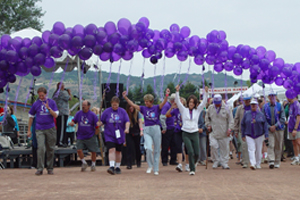The American Cancer Society, the nation’s largest and oldest cancer-fighting charity, is halfway through a system-wide refocusing to sharpen its mission delivery: saving more lives and curing cancer.
The transformation initiative has been described as “re-engineering the plane while we fly it,” CEO John Seffrin, Ph.D., said. It’s an interesting analogy since the Wright Brothers had their historic flight in 1903, just 10 years prior to the ACS opening its doors. Along with a reorganization, the ACS is celebrating its 100th anniversary this year.
“This is not a tweaking at the edges, or developing a new project. It’s a fundamental look at your whole operation, your whole platform,” Seffrin said. “Early on, the only thing we took off the table was our mission statement.”
Included in the process is the dumping of some individual fundraising, the buy-out of approximately 5 percent of employees, a restructuring of management and centralizing of virtually all back office services.
Seffrin said he presented the national board with data three years ago showing that the society was saving 350 more lives per day than it was in 1991. He also told them it could be 1,000 per day – not with a major medical breakthrough but simply by reaching more people.
“We can get incrementally better but we can’t get to 1,000 lives in our current platform. We have evidence we could get there if we’re willing to take a hard look at ourselves,” Seffrin said during an interview at the charity’s Washington, D.C. office in April, shortly after a new division field structure was announced internally.
“What really is driving the organization, and me, is the tsunami of non-communicable diseases that we’ll face domestically and globally over the next 20 years,” said Seffrin. He repeatedly talked about presenting the transformation to his board as a “moral imperative.”
It would have been easy to not do anything, be happy and believe you’re a great organization, said Gary Reedy, chairman of the national board who also chaired the National Board Advisory Committee on Transformation. “But that wasn’t an option,” he said.
ACS is not hurting for cash. Its total revenue last year was $953 million, of which more than 40 percent was through its thousands of Relay for Life events. But a compound annual growth rate of 2 percent wasn’t enough compared to younger charities that were growing faster, such as LiveStrong and Susan G. Komen for the Cure. “We’re not growing at a rate we used to be and I think there are some reasons for that, in terms of relevancy,” Seffrin said.
Seffrin touts ACS as the first volunteer health charity to raise $1 billion in a single fiscal year (fiscal years 2006, 2007 and 2008) through a median gift of $25. To raise $2 billion through $25 gifts is possible but it’s not responsible stewardship because of the expense of raising those gifts. That’s one reason why the society mothballed its direct mail acquisition program. “Our future is inextricably tied to major gifts and corporate investments,” Seffrin said.
The direct mail acquisition and conversion program ran a deficit of about $200,000 last year, after expenses of $10.2 million and revenues of $10 million, based on 19 separate campaigns.
Not The First Time
It’s certainly not the first time – even recently – that ACS has consolidated operations in some fashion. The Illinois Division merged early this year with the Great Lakes Division to become the Lakeshore Division, after Illinois CEO Steven Derks left last year to become CEO of Muscular Dystrophy Association (MDA). The move left 11 ACS divisions.
The national home office merged with the South Atlantic Division and the Atlanta Metro Unit into one facility in 2007. In 2001, ACS merged back-office operations, such as data collection and donation processing into a share services center shared by then 17 divisions, national headquarters and its advocacy affiliate.
The ACS is the latest national organization to consolidate affiliates and operations in recent years. American Heart Association (AHA) and American Diabetes Association (ADA) both consolidated their operations around the country into geographic regions, starting about 15 years ago. ACS executives said the organization didn’t go as far with its consolidation at the time, and something like this transformation probably would not have been pushed through.
Had a straw poll been done at the start of this process, it probably would have been overwhelmingly rejected, said Mike Dany, executive vice president of the High Plains Division in Austin, Texas. He credits involving volunteers from the start in discussion about what would make ACS more effective and impactful. “That began discussions and we were deliberate about volunteers and staff and what would that look like. It started with, ‘What would we do to become better,’ and solutions started to fall in place,” he said.
Consolidation during the 1990s was not necessarily a wrong move but executives said a complete overhaul of the organization would have been premature. At the time, it didn’t go nearly as far, merging dozens of divisions and moving some back-office functions to the national headquarters in Atlanta, Ga.
A combination of what was previously feasible, readiness in the face of an economic “new normal” and evidence presented to the board helped to spur the current organization-wide overhaul, said Seffrin. “If we’re leaning on a 1950s, 1960s model, we’re not going to be successful,” he said.
Combining all geographic divisions and the national office into a single entity, with one governing body, is expected to improve the charity’s “decision velocity.” The 43-member National Board of Directors used to report to the 137-member National Assembly. The 13 divisions each were their own, separate entity, governed by their own boards, with their own audits and tax forms.
The National Board of Directors set the strategy for the ACS, but division boards could decide to what extent they could opt in or opt out. “We took so much pride in independence, what we really need to work toward is greater inter-dependence,” Seffrin said.
“The old model was very unwieldy, in terms of how it got resourced. Each division required an executive, an audit, all the trappings of a corporation,” said Dany. “For us to get to the next level of optimization required us to take that last governance change,” he said.
“We weren’t terribly different but just different enough that we couldn’t optimize how the organization worked internally,” said Dany. Now as a single operating model, ACS can train staff consistently and offer the same tools and resources throughout the country.
Another executive argued that divisions were likely doing things different for reasons other than data-driven ones. “The marketplace now demands that experience be in a consistent manner,” said Don Gudaitis, executive vice president of the New England Division. He added that to reach 1,000 lives a day, ACS had to accelerate the way it does business.
An organizational health survey that all leadership volunteers and staff had a chance to participate in showed some areas ripe for improvement. Sharing data helped to build a “compelling story that we really need to change,” Reedy said. “Some of us wanted to change yesterday, there were others who were much more reluctant. They probably saw this as a takeover,” he said.
The charge to the governance subgroup was to devise the best model of governance. “If you were starting the American Cancer Society today, to build as effectively as possible, build mission as quickly as possible, what type of governance model would you have,” asked Reedy.
Volunteers came up with three models. In addition to the single national organization, one model didn’t change anything and another would have kept some regional governing boards. The governance committee then went around the country to bring together volunteers to try to build consensus on a model. “There was a lot of healthy debate,” Reedy said.
To get 6,000 staff and three million volunteers “marching down the road at the same time was nearly impossible,” said Reedy. “Fast forward two or three years and the public will have a great appreciation for what the society is doing and what it is not doing, and much more impact on the role that we’re playing,” he said.
American Cancer Society’s centennial year of 2013 is seen as critical because it’s in the midst of the implementation phase of a new division operating model, establishing new positions and distributing its talent and human resources consistently throughout the organization. Executives point to 2015 as to when they expect these massive changes to pay off on the bottom line.
In its 2012 Stewardship Report, ACS cited that an analysis encompassed about $680 million in spending and projected savings of $40 million over the next two to four years, by building out and streamlining our nationwide strategic sourcing and procurement strategy for outside vendor supplies and services.” ACS reported $11 million has been realized through “cost savings and cost avoidance,” and original estimates might be conservative. Officials said those efficiency initiatives were under way prior to the transformation process.
The new structure is much flatter, with fewer levels and steps between Seffrin and on-the-ground positions, and a more efficient staff-to-management ratio, said Dany. “Hopefully it’s helpful in speed and best use of talent,” he said.
There’s no need for the organization to have 14 chief financial officers (national office and each division) but Seffrin warns that doesn’t mean the organization doesn’t need financial expertise. ACS’s divisions are expected to get close to 100-percent mission delivery now that most redundancies have been eliminated and mission support services are at the corporate center, Seffrin said. ACS is at about 72 percent of funding toward mission, and aims to get to 80 percent after the transformation.
There will be programs that will be eliminated, including some that were started on a regional basis but never scaled nationally, Reedy said. The organization will be much more astute in looking across programs and examining return on investment to determine its impact, but also whether it’s scalable, he said. “Is it something we can do across the country, instead of one or two regions?”
In addition to dropping donor acquisition mail, ACS will move away from cancer camps. “It was a graceful exit with no hard feelings because communication was there and the understanding of why we would exit was considered reasonable by them,” said Gudaitis. Camps will be funded by remaining restricted dollars and turned over to volunteers not under the ACS banner.
Three Years In The Making
The transformation seem to have at least been seeded around January 2009, when ACS leaders and McKinsey & Co. took at hard look at the charity’s business practices nationwide. In May 2010, Seffrin made his presentation to the National Board of Directors and by August 2010, the board adopted a resolution in support of ACS’ transformation.
What eventually developed were 11 initiatives to address six principles that would transform the society, presented to the organizational as a whole in a February 2011 paper by Seffrin.
Barely a year later, at the annual meeting in November 2011, the National Assembly voted to accept the board’s recommendation and dissolve itself. The National Board of Directors is now the only governing body. “The buck stops with us now,” said Reedy, vice president government affairs and public policy for Johnson & Johnson.
After the National Assembly dissolved itself, there were discussions about the board’s size and composition going forward. “If we’re changing the governance model and have one national board, then do we have the right size and composition board to steer the Society under this new governance model going into the 21st century? That’s one thing that at the division board level, people were saying,” Reedy said.
At a February board meeting, there seemed to be support for reducing the size of the board “because you get 43 people around a table trying to move things forward, it’s just very challenging to do,” he said. If the board does get reduced, the nominating committee will proceed with who would retain a board seat. Reedy doesn’t expect it to be a contentious issue, recalling the words of a previous board chairman: “I don’t know anyone who joined American Cancer Society to get into a governance role.” Reedy himself will rotate off the board after next year, returning to a community volunteer role.
The Atlanta, Ga.-headquartered charity officially merged its remaining 12 divisions around the country into a single, nationwide corporate entity this past September. In March, a Voluntary Separation Program (VSP) was offered for employees as the charity recalibrates thousands of positions. Some 342 staff of an eligible pool of 4,300 opted for the package.
57 to 17 to 13 to 11
When Seffrin became CEO in 1991, there were 57 divisions of ACS around the United States. Some consolidation among affiliates began several years later and eventually got down to 17, with moves such as creating the New England Division by combining six existing state divisions.
Ohio and Pennsylvania merged in 2010 to create East Central. After the Illinois Division’s CEO left, it merged with the Great Lakes last year to become the Great Shores Division, encompassing Illinois, Michigan and Indiana.
After this transformation process, each division’s board of directors no longer has governance duties but instead serves as an advisory board. Likewise, each division’s CEO has a new title of executive vice president and a new organizational chart.
“All of our field executives a year ago were CEOs of multimillion-dollar enterprises,” said Seffrin. He offered each the opportunity to continue as the chief executive but in addition to running their territory, they would have an enterprise-wide responsibility.
For Dany, it’s been creating the division operating model for the past year. California Division Executive Vice President David Veneziano and Ralph DeVito of the Florida Division head-up innovation.
The operating model has been getting built in stages, first with the classic corporate center functions. “As we began to consolidate governance, we consolidated IT, finance, talent, that’s fairly consistent with the way most large-scale organizations operate, centralizing those functions,” said Dany.
Each division now has a leadership team of five people — which varied in the past — each with a focus area, such as corporate partnerships, engagement and health.
Two of 12 former division CEOs are no longer with the organization. Garry Pincock, formerly CEO of the East Central Division, retired and Derks, the Illinois Division’s CEO, last fall joined the Muscular Dystrophy Association as CEO. Through an MDA spokesman, Derks declined comment, referring questions to ACS. Efforts to reach Pincock were unsuccessful.
Voluntary Separation Program
Employees with at least three years of service at ACS were offered $1,000 for each year of service as part of the voluntary separation program. The 342 employees represent about 5 percent of overall staff and were in “a variety of departments, disciplines, levels and tenure. There was no concentration in employees in any one category or location,” according to ACS. About 4,300 employees in all were eligible “based on service requirements and other provisions.”
An ACS spokesperson said ACS is in the process of closing out the program and did not have cost estimates to share publicly. Initial estimates were that some 20 percent of the positions vacated would be replaced but that actual number to be replaced is still being finalized. There were no specific financial goals for the program, according to ACS, but “eliminating redundancies and maximizing the impact of programs and services is at the core of the society’s transformation efforts.”
There hasn’t been a huge pushback but Seffrin expects anxiety in some places just because of change. “Inevitably, there will be changes, but there will always be jobs for high-performing people, and we’ll go from there,” he said. “I think we’ll be in an even better place in the next few months, relative to right sizing, but more importantly, deployment of talent.”
The couple of years it took to get to decisions and the level of communication “went most of the way to ameliorating” concerns, said Gudaitis, who’s been with ACS for some 38 years. “I’m on the back nine of my career at the cancer society. If I were 10 or 15 years younger, I might have a higher level of anxiety. But to me it was so clear that this was the best way for the organization to proceed,” he said.
“If the change is significant enough, you’re just not going to bring 100 percent of your people,” staff and volunteers, said Dany. “And that’s probably OK, you’d probably never move if you’re trying to make everyone OK.”
A Business Case
Gudaitis preferred the title of CEO of the New England Division, running an $80-million operation, but he decided to stay with the charity. Replicating the human resources and finance and other back-office operations a dozen times creates inefficiencies.
Board members ultimately will support a business case for operating in a more effective way, he said, and volunteer boards individually needed to support this to make it happen, just as when six states merged to create the New England Division. “Each of those boards needed to actively, legally vote themselves out of business,” he said.
“Ultimately why people get involved in the governance situation is belief in the mission,” Gudaitis said, and over time that sometimes gets displaced a bit by the satisfaction of playing a role in governance.
Seffrin and other executives expect 2013 might be the most challenging year of the transformation. It’s a pivotal transition year because of the implementation phase. The current step is creating the division operating model, which is built on the mission and resources done now but also directing growth for future opportunities.
“Deliver what you do now but also take on new opportunities; that was our charge. We were never asked to come up with numbers or get to ‘X’ cost. We built first around, what’s our role,” said Dany. In the previous division model, roles were defined by a 60-40 split of revenues (60 percent stayed locally, 40 percent went to the national office). “We did what we did very often because we had 60 percent of resources, and national too,” he said.
ACS could have followed a product model, organizing resources around products, or pursued a purely geographic model organized around cities and small towns. “We chose constituencies and systems. First off, we know that tactics will change. The society is doing things that we didn’t think of 10 years ago,” said Dany.
Communities no longer just organize around geography but around interests or demographics, thanks to the Internet, one reason why ACS didn’t pursue a geographic division operating model.
“We know our products are going to change, our focus might change but constituencies will stay the same,” said Dany, “if we maintain great relationships so they’re not just a one-off.” NPT
Note: The original version of this story needed correction or clarification. American Cancer Society (ACS) Board President Gary Reedy was correctly quoted as saying ACS has 3,000 staff. However, the organization has approximately 6,000 staff. John Seffrin, Ph.D., is the CEO, not president and CEO, of the ACS. Finally, the merger of the Illinois and Great Lakes Division occurred early in 2013, not late 2012, and is now called the Lakeshore Division, not the Great Shores Division.












